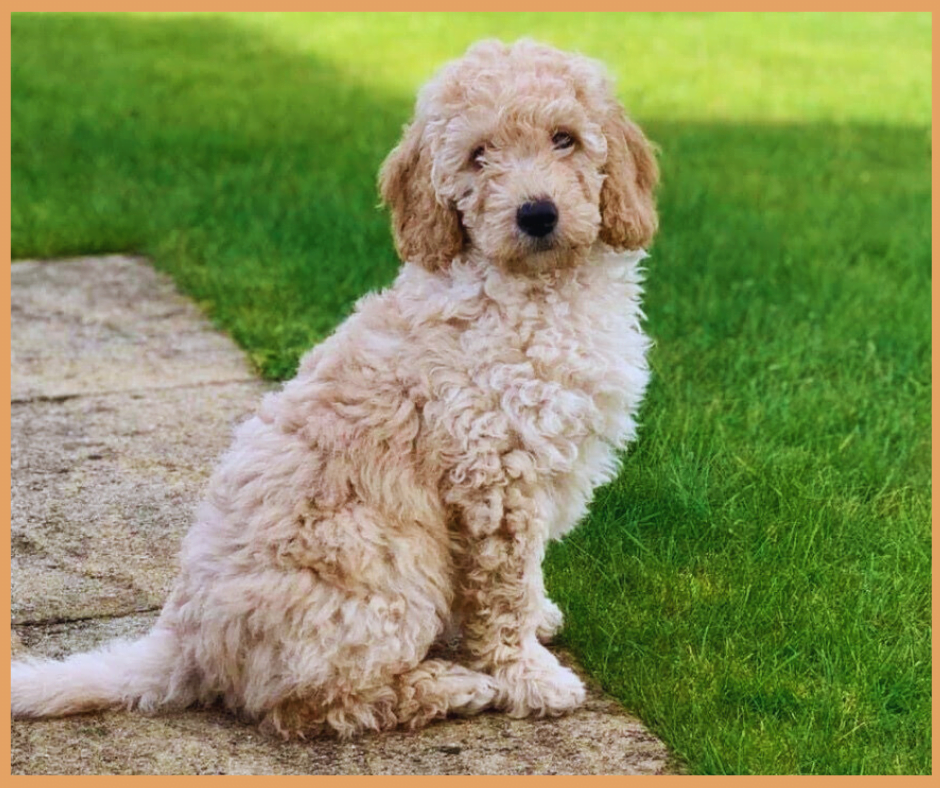The miniature labradoodle, a prevalent combo dog breed, has a significant love quotient because it’s marvelous to converse with and easy to have around significantly since it won’t worsen your allergies. It doesn’t take up too much space.
This dog is unique because it’s an exciting combination of a Miniature Poodle and a Labrador Retriever, which means it gets the fantastic parts from both kinds of dogs.
Here, I examine everything about the miniature labradoodle intensely. Suppose you’re thinking about getting one as a new family member or just curious about them.
In that case, this overview will cover the must-know material from how long they remain to how large they get to what one might cost and other essential things to consider.
History and Background of the Miniature Labradoodle
Here’s a simple and informative table summarizing critical details about the Miniature Labradoodle breed:
| Feature | Details |
|---|---|
| Origin | Late 20th century, a cross between a Miniature Poodle and a Labrador Retriever |
| Lifespan | 12-15 years |
| Size | 14-17 inches tall |
| Weight | 15-30 pounds |
| Coat Type | Curly or wavy, low-shedding |
| Hypoallergenic | Generally considered hypoallergenic |
| Exercise Needs | 30-60 minutes per day |
| Temperament | Friendly, intelligent, affectionate |
| Good with Children | Yes, great with children |
| Barking Tendencies | Moderate, can be controlled with training |
| Cost | $1,500 – $3,000 (from a breeder) |
| Grooming Needs | Regular brushing, occasional trimming |
| Health Concerns | Hip dysplasia, eye issues, skin allergies |
| Adaptability | Suitable for apartments and smaller homes |
The miniature labradoodle is simply a tinier form of the labradoodle. This young dog, mixing the genes of a Labrador Retriever and a Miniature Poodle, first appeared towards the end of the 20th century.
People wanted a dog that was friendly, intelligent, and active, didn’t trigger allergies, and could comfortably fit into smaller homes, and that’s how this breed came into being.
Originating from the original labradoodle breed developed in Australia, the miniature labradoodle inherits the adaptability that made its predecessor famous.
These dogs were initially bred as guide dogs and chosen for their Hypoallergenic qualities. Their adaptability, quick socialization skills, and low-shedding coats make them perfect for almost any living situation.
They are very good at quickly becoming everyone’s favorite pet since they remain for a long time. It’s unusual, but sometimes some associations don’t officially accept them even though many families and single people consider them the ideal, friendly pet they’re always thrilled to have around.
Lifespan of a Miniature Labradoodle

Miniature Labradoodles have the potential to live for 12 to 15 years, a significant lifespan for a dog.
This longevity is due to the typically robust health of their parents, the Poodle and the Labrador Retriever.
By providing regular vet visits, proper nutrition, and ample playtime, you can help ensure your Miniature Labradoodle reaches this impressive age and enjoys a happy, healthy life.
Size and Weight of a Miniature Labradoodle
Sometimes, yet rarely, they get sick early, but if you catch those sicknesses early, they can live even longer.
When we discuss how large these dogs get, miniature labradoodles are not too large but not highly tiny either. They usually grow to be somewhere between 14 and 17 inches tall.
Depending on their parents’ genes, they could weigh around 15 to 30 pounds.
Because of their small size, they fit well in smaller places like apartments and are extremely simple for anyone, even young people, to handle successfully.
People enjoy bringing them home because they’re the right size for most places.
Coat and Grooming
Miniature Labradoodles usually have soft coats that can be curly or wavy, and they don’t shed much, which is excellent for people with allergies, though one can see that not all of them look the same.
Some have fur that’s more Poodle-ish, all curly, while others have a shorter coat that looks more like a Lab’s. To keep their fur looking good, they must be taken care of a lot; you must brush them a couple of times a week so their hair doesn’t get tangled.
They need to be trimmed now and then to keep looking neat. They also need baths sometimes and their ears cleaned to prevent infections, especially since their ears are soft and hang down.
Temperament and Personality

The upshot of the entire piece is that miniature labradoodles are excellent pets for families or anyone wanting a kind companion. These dogs are incredibly clever and quickly learn new tricks because they love making people happy.
More than that, they are incredibly friendly and always ready to meet new people and make new friends. Like any other dog, miniature Labradoodles must start learning social skills and commands early to be their best.
They get along well with young people, other animals, and even people they don’t know. They’re also famous for being extremely sweet, intelligent, friendly, and always up for a meeting, which is why they make excellent pets for anyone.
Exercise Needs
Miniature Labradoodles might look small, but you better believe they’re bursting with the energy they need to burn off to stay upbeat and fit. For these pups, running after balls, learning new tricks, and swimming are marvelous ways to tire them out because their Labrador parents loved this content, too. They must get their daily dose of fun and brain games so they don’t start making a mess in the location or become stubborn from too much unused energy.
Health Considerations

Despite their lively behavior, Miniature Labradoodles are not immune to health issues inherited from their lineage. It’s essential to be aware of these potential health concerns and take necessary precautions to ensure their well-being.
Their hips might not be all they should be, meaning they could get arthritis or have trouble walking as they age. Then there’s this problem with their eyes, where they could slowly lose sight because of a bad gene from their parents. In addition, itchy skin and bad reactions to certain foods can also make the list of trouble for them.
Pumping these furry athletes full of physical and mental action is critical. It is the secret sauce for keeping their muscles strong and minds sharp, so they take your sneakers as their favorite thing to chew on.
Cost of a Miniature Labradoodle
The price you’d spend on a miniature labradoodle varies greatly. This depends on factors such as where the dog is coming from, who is selling it, and its family tree, but overall, expect to spend between $1,500 and $3,000 if you’re getting one from a well-thought-of breeder.
It may have once seemed unfathomable, but we know these tiny dogs can seriously dent your wallet.
And just so you know, buying the puppy is just the start. More money should be spent on keeping your dog happy and healthy. Think of snacks, keeping them looking sharp, checking in with the vet, and getting pet insurance.
If you’re more inclined to get a miniature labradoodle from a rescue spot, it’s usually cheaper. Adoption fees range between $200 and $500.
Conclusion
Miniature Labradoodles are spectacular because they’re intelligent, informed, cute, and easy to get along with. Many people love having them around.
They’re not too large, so you don’t need a large house or anything to keep them happy, which is fantastic for everyone, whether you’re living solo, alone, or staying with your grandparents.
They only shed a little bit, and because they don’t make a disaster with fur everywhere, people who don’t want hair all over enjoy them. Also, thanks to their unique fur, people who sneeze around dogs might not have that problem with miniature Labradoodles.
But if you decide to get one, you must be ready to keep up with their haircuts, ensure they do a lot of running around, and take them to the vet so they stay healthy.
If you’re interested in adding a friend to the family who’s full of love, can keep up with you, and isn’t afraid about the fuzz issue, a Miniature Labradoodle could be your match. They can live for 12 to 15 years, which means you’ll have a furry friend for a long, good time.
Frequently Asked Questions
Are Miniature Labradoodles Hypoallergenic?
Miniature Labradoodles are often hypoallergenic due to their low-shedding coats, but individual reactions to allergens can vary.
How Much Exercise Does a Miniature Labradoodle Need?
They need about 30 to 60 minutes of daily exercise, including walks, playtime, and mental stimulation.
Do Miniature Labradoodles Bark a Lot?
They generally don’t bark excessively, but proper training can help minimize unwanted barking.
Are Miniature Labradoodles Good with Children
They are friendly and gentle, making them excellent companions for families with kids.
What Is the Difference Between a Miniature Labradoodle and a Toy Labradoodle?
The main difference is size: Toy Labradoodles are smaller, typically under 15 pounds, while Miniature Labradoodles weigh between 15 and 30 pounds.

